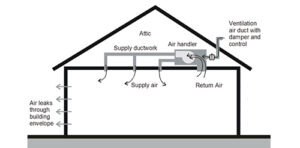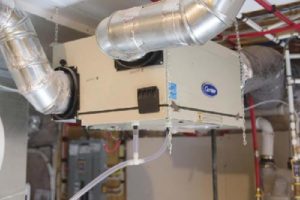
Whole house ventilation is an important topic when designing for improved indoor air quality in a well-insulated and tightly sealed Katahdin Cedar Log Home. There are several strategies depending on the climate in which your new log home is constructed. Let’s talk about the options.
Exhaust-only Ventilation
Exhaust fans can be installed using a variety of appliances: kitchen, bathroom and whole house fans. Because they only push inside air out, they have the effect of depressurizing the house. This draws in air from other openings in the house envelope. Here the problem is excess moisture during the summer months. In the north with milder dryer summers a buildup of moisture is unlikely to be a problem. Exhaust only ventilation is not recommended in the south, as the depressurization draws in humid air that may cause moisture buildup that can be difficult to resolve.
Supply-only Ventilation 
This ventilation draws in clean outside air from a single source, generally a supply vent that feeds into the forced air system. These controlled supply systems pressurize the house, which can keep outside air infiltration down. Advantages of a supply only ventilation is the control it affords. By drawing air in through one point, it can be treated, humidified and filtered before distribution throughout the home. In hot, humid climates, supply only pressurization can minimize infiltration of humidity, but in colder climates condensation in the walls can occur as the warm air moves out.
 Balanced Ventilation
Balanced Ventilation
These systems exhaust indoor air and provide outside fresh air in equal amounts, keeping the interior home air pressure relatively constant. These systems require a very tightly sealed home and good engineering to keep the balance working. Generally, these systems rely on powered heat recovery ventilator (HRV) or energy recovery ventilator (ERV) to regulate the incoming and outgoing air flows. HRVs recover heat only, while ERVs recover energy and remove humidity, making them the preferred choice for southern high humidity climates.
The Benefits of Controlled Ventilation
Both exhaust only and supply only ventilation rely somewhat counterintuitively on added ventilation from cracks and gaps in poorly sealed homes. Tightly air sealed homes with exhaust-or supply-only ventilation can develop problems surrounding poor air quality, moisture buildup or heating appliance backdrafting. Balanced ventilation provides the right amount of clean air exchanges while cutting down on energy loss and lowering heating and cooling bills. Balanced controlled ventilation can keep indoor air pollution problems to a minimum and make for a healthier home.
It’s important to include ventilation in your discussions with your heating and cooling contractor, to ensure your strategy fits your home and your climate.
